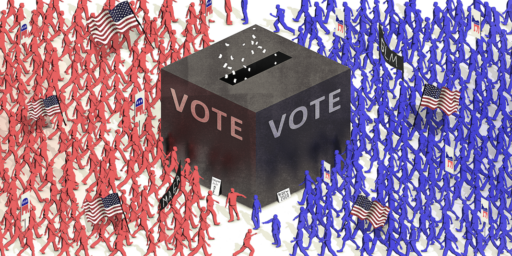BROKEN CONGRESS
Richard E. Cohen, Kirk Victor, and David Baumann have a depressing review of the changing norms of our national legislature in the current National Journal. They cite the contentious Medicare bill, which was rammed through through some extremely heavy-handed tactics, as Exhibit A. Ironically, they cite statements made by then-House backbencher Newt Gingrich complaining about the tyranny of the Democrats who had controlled the House for decades.
They cite a series of problems with the modern process, each linked to a “story” that explains it in great detail:
- The disintegration of the committee process (story);
- The greater concentration of power in the hands of House leaders (story);
- The increasing use of the House rules to deny the minority a full debate or votes on its views (story);
- The increasing use of filibusters, amendments, and holds to clog up the legislative works in the Senate (story);
- The lack of true debate in the Senate (story);
- The breakdown of the budget process (story);
- The heavy reliance on riders to the must-pass appropriations bills as a crutch to act on significant policy issues (story);
- The refusal by appropriators to fully fund authorization bills (story);
- The tendency toward government-by-CR(story);
- The majority party’s abuse of the conference committee (story);
- The lack of true bipartisanship and the polarization of Congress (story);
- The inability or unwillingness of Congress to make thorough use of its oversight powers to keep the executive branch in check (story).
National Journal‘s analysis found that in some cases, these institutional trends have been exacerbated or have accelerated since 1995, when Republicans took over Congress. But the GOP isn’t entirely to blame. Many of these institutional trends have been building over several decades, at least, and were well evident during the years of Democratic control. And a few of these developments in Congress merely reflect broad shifts in society or in the electorate. Moreover, in some respects, rank-and-file Republicans and Democrats are equally complicit in contributing to the state of affairs on a daily basis. In other words, both parties bear considerable responsibility for the state of Congress.
One thing is clear: The way that Congress operates these days bears little resemblance to the models described in the social-studies textbooks and civics primers of days gone by. Take the 80-page pamphlet, How a Bill Becomes a Law: Congress in Action. The guide was written in 1948 by two senior Senate aides, apparently for school children, and was published by the private National Capitol Publishers. Its pages feature cartoons of lawmakers debating politely, for the most part, while the text describes the legislative process in high-minded tones.





